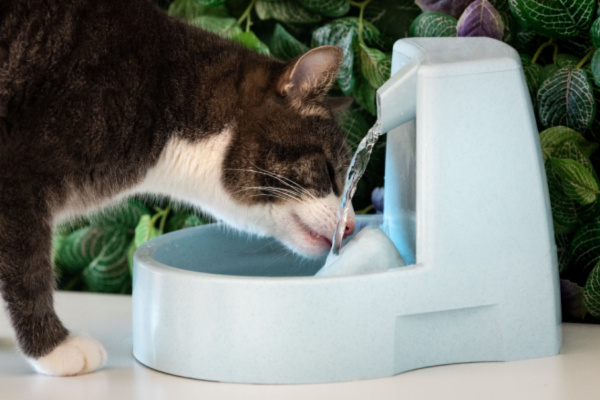July is National Pet Hydration Month. With scorching summer temperatures seen all across the country, it’s important to keep ourselves – and our pets – hydrated. While keeping water readily available for both indoor and outdoor pets may seem like common sense, the summer heat provides an opportunity to talk about the symptoms and dangers of dehydration as well as overhydration.
Signs and Symptoms of Dehydration for Dogs & Cats
According to the American Kennel Club (AKC), these are the common symptoms of dehydration to watch out for:
- Loss of appetite
- Reduced energy levels
- Lethargy
- Panting
- Sunken, dry-looking eyes
- Dry nose and gums
- Loss of skin elasticity
You can test your pet’s skin elasticity with this test: gently pinch the animal’s skin between thumb and forefinger. Explain that skin will spring back into position in well-hydrated animals, while it takes longer if your pet is dehydrated. You can also check your pet’s gums, checking for moist versus dry, tacky feeling gums.
As Pet Safe notes, increased water intake also is important to avoid urinary blockage in cats. Symptoms include:
- Straining in the litter box
- Crying/howling
- Licking genitals or below base of tail
- Hiding
Signs and Symptoms of Overhydration
For those four-legged patients who can’t get enough of the pool, garden hose or swim time, Healthy Pets wants pet owners to beware of the dangers of water intoxication. Although hyponatremia is relatively rare, it is possible for dogs to ingest large quantities of water when splashing for extended periods of time. Symptoms of water intoxication include:
- Loss of coordination
- Lethargy
- Bloating
- Vomiting
- Glazed eyes
- Excessive salivation
- Difficulty breathing
- Seizures
- Coma
Did you know…? As much as 80 percent of a pet’s body is water, compared to 55 to 60 percent in humans?
General Rule and Tips for Daily Water Consumption
According to Pet MD, the general rule for daily water consumption is one ounce of water per pound of body weight daily. If you’re concerned about whether or not your pets drink enough, consider these tips:
- Always stock a fresh supply. You don’t like floaters in your cup. While pets may not be quite as picky, a clean supply is always more appealing.
- Clean the water bowl. A clean bowl is equally as important as fresh water. Wash water bowls daily to prevent bacteria growth.
- Keep it moving. Do you have a pet that likes to drink from the faucet? For pets that prefer moving water, pet fountains keep water circulating and your taps safely shut off! If you do opt for a water fountain, don’t forget to change the filter and clean per the manufacturer’s instructions.
- Consider adding wet food or supplementing with fresh raw fruits or vegetables for added water intake.
Watch your pet for a change in amount of water consumption. According to Healthy Pets, it may also indicate illness. For example, dogs with pancreatitis, parvovirus or leptospirosis tend to drink less water, while bladder infections, Cushing’s disease and diabetes can lead to excessive thirst and drinking.
With these simple tips, pet owners can help to keep their pets safe, healthy and hydrated during the hot summer months.
Do you have a large animal pet? The University of California Division of Agriculture and Natural Resources offers this resource to determine daily water requirements for large animals.
—
Photo Credit: Creative Cat Studio / Shutterstock.com
